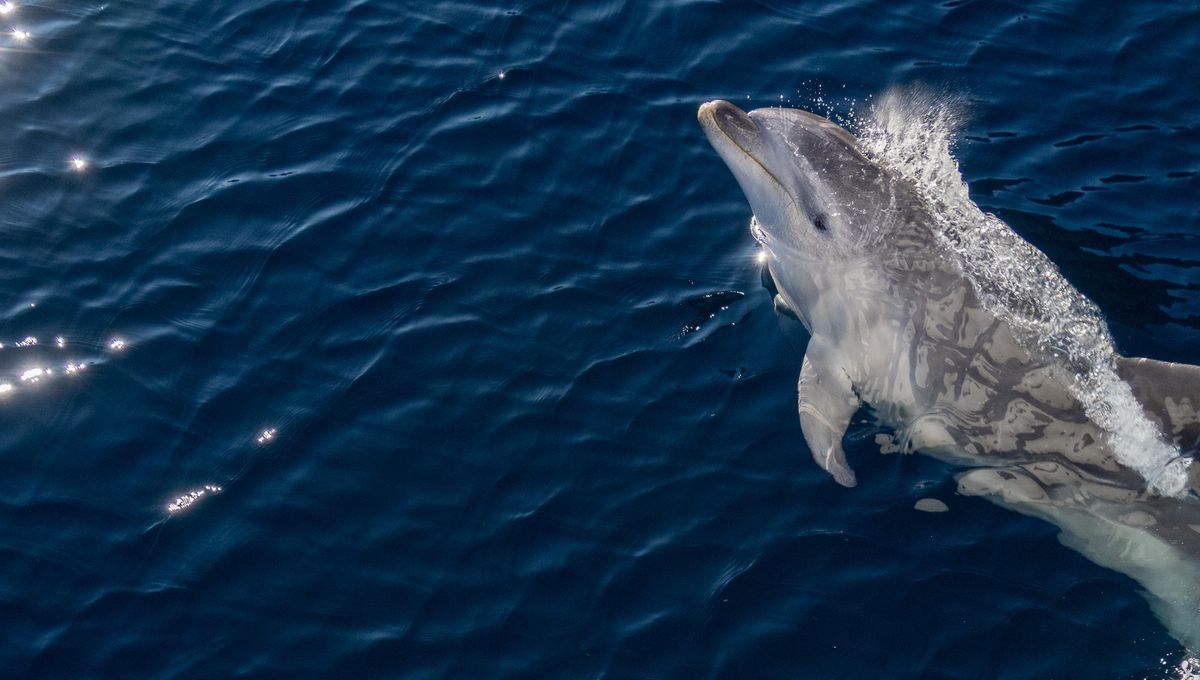
Dr Dara Orbach is a field biologist who conducts regular surveys of cetaceans, namely dolphins, in her Gulf of Mexico home waters. During a routine workday in 2013, Orbach encountered a deceased dolphin “so fresh that its tail was still twitching.” She did what any researcher might do – collected the specimen for future analysis.
Several years later, Orbach instructed a doctorate student to use the dolphin to test compounds with a mass spectrometer to trial different sampling techniques through what’s known as an untargeted analysis. That is, scientists simply run a sample to see what outcomes are generated.
The science team was shocked by the unexpected results.
“Hundreds of pharmaceuticals and compounds generated from this one dolphin,” Orbach told IFLScience. “We weren’t thinking about pharmaceuticals, and we were blown away.”
From here, Orbach designed a study to determine whether other dolphins may also have traces of pharmaceutical drugs in their blubber.
Bottlenose dolphins are considered to be bioindicator species that signal ecosystem health. This means changes in their life cycle can indicate changes in their broader ecosystem and environmental conditions to provide clues to the habitat’s overall health.
Dolphins are both an apex predator, meaning they’re at the top of the food chain, and a bioindicator species that lend clues to ecosystem health. In particular, their blubber can sometimes serve as a warehouse for environmental contaminants like pharmaceutical drugs.
“Things we don’t want to be eating or consuming – our cetaceans are telling us how much of that is in our environment,” said Orbach.
To explore the presence of pharmaceutical contaminants in the marine ecosystem, Orbach and her team analyzed blubber samples from 83 live, free-swimming bottlenose dolphins (Tursiops truncatus) in the Gulf of Mexico and six deceased dolphins.
Samples from each animal were tested using ultra-performance liquid chromatography and Orbitrap Fusion Tribid mass spectrometry. In other words, high-quality chemistry instruments that separate out and measure the masses of different compounds and compare them against known values.
Pharmaceuticals were found in the blubber of 30 of the dolphins dolphins tested, including opioids, muscle relaxants, and sedatives. In particular, fentanyl – an opioid analgesic that is 100 times more potent than morphine – was found in 18 of the live dolphins and all of the dead ones.
The team cannot definitively confirm that fentanyl killed the dolphins, but exposure may have contributed to a population already pressured by habitat loss, disease, noise pollution, and algal blooms.
“If you add one more stressor to an already susceptible population, is it enough to tip the scale and push these animals past their point of survival? Sure,” Orbach told IFLScience.
Pharmaceutical pollution may be a long-standing issue that has been largely overlooked.
Dr Dara Orbach
Blubber is full of fat and some pharmaceutical drugs like fentanyl are lipophilic, meaning they are attracted to and dissolve in fat, allowing them to accumulate in blubber over time.
“Fentanyl targets fatty tissue, and blubber is as fatty as it gets,” said Orbach.
Because fentanyl targets fat cells, it’s not surprising that the drug was found in more samples than other drugs tested. What is “really shocking” is the presence of the muscle relaxant carisoprodol and the sedative meprobamate, which were detected in 5 percent and 1 percent of blubber samples, respectively. These drugs don’t bind as easily to fat cells, and their presence suggests contamination may be wider than anticipated.
“That we’re even finding them is potentially alarming, since you wouldn’t expect them. If you’re finding something that doesn’t target fat cells in fat cells, to me, that means these animals have extensive exposure,” said Orbach.
The study is one of the first to look at pharmaceutical levels in apex marine predators, and presents the first detection of human drugs in live, free-swimming marine mammals. But the issue itself is far from new.
“Some of these tissues were collected in 2013 – that we’re finding 12 of our samples, 40 percent, with detections more than a decade later shows that this is a longstanding issue that no one had been looking at,” said Orbach. “Pharmaceutical pollution may be a long-standing issue that has been largely overlooked.”
We really don’t know if – or how – deadly or dangerous these drugs are when present.
Dr Dara Orbach
What’s unknown is whether dolphins and other animals exposed to pharmaceuticals experience the effects of the drugs. Dolphins studied had very low doses in general, but that’s not to say there isn’t an effect.
Fentanyl, carisoprodol, and meprobamate can cross the placental barrier of a mother and her fetus. Nursing mothers can also transfer toxins to their offspring through lactation – though this has not yet been explored in cetaceans.
“We really don’t know if – or how – deadly or dangerous these drugs are when present,” said Orbach.
Dolphins, for example, don’t drink water but hydrate through water obtained when consuming prey like fish, which are often the same species humans commercially harvest and eat.
“This paper serves as a stepping stone to ring an alarm, saying we need to start looking across ecosystems more globally and across trophic levels,” said Orbach.
How pharmaceuticals reached the dolphins’ habitat was not studied, but previous research has found that transfer may occur through insufficient wastewater treatment or untreated discharge from pharmaceutical manufacturing facilities. In some cases, animal manure containing veterinarian pharmaceuticals has been shown to infiltrate water systems through runoff.
The authors write that these findings “reinforce the need for large-scale assessments” across ecosystems to determine the severity of potential contamination.
The pre-proof findings are published in the journal iScience.
Source Link: Fentanyl Traces Found In Blubber Of Wild Dolphins In Gulf Of Mexico